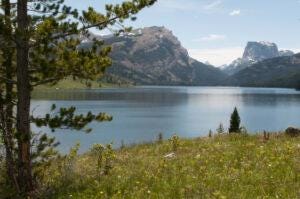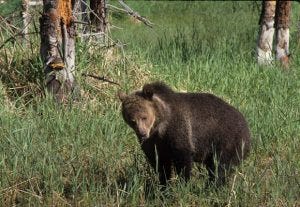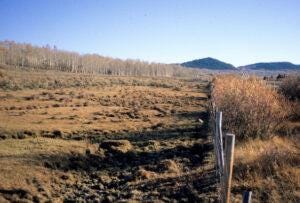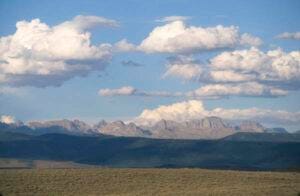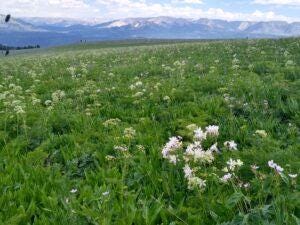Judge's Decision on Upper Green Grazing Allotment Betrayal of Public Trust
Continued grazing may result in the death of up to 72 grizzlies
The Upper Green River flows through the center of the 170,000-acre grazing allotment on the Bridger Teton National Forest. Photo George Wuerthner
A federal court recently dismissed the lawsuit initiated by The Center for Biological Diversity, Sierra Club, Western Watersheds Project, Alliance for the Wild Rockies, and Yellowstone to Uintas Connection to protect grizzlies in the Upper Green River area of Wyoming from the negative impacts of livestock grazing.
The decision will permit the Bridger Teton National Forest (BTNF) to go forward with its recent decision to renew a ten-year grazing permit on the 170,000-acre grazing allotment.
The Upper Green originates in Green River Lakes in the Wind River Range. Photo George Wuerthner
The Upper Green allotment is the largest single Forest Service allotment in the West. It is the best wildlife habitat in the West and comparable to the Lamar Valley in Yellowstone National Park.
With the Green River running the length of the allotment, the area is dominated by sagebrush with clumps of aspen, willows, and conifer patches. Small tarns and tributary streams add to the diversity of the landscape.
Between 2010 and 2018 35 grizzly bears have been killed or removed from the allotment as a result of conflicts with privatly owned livestock utilizing public lands. Photo George Wuerthner
The area has seen increasing use by grizzly bears. Between 2010-2018, 35 grizzlies have been killed or removed from the site over conflicts with livestock. It is an example of where “problem livestock” are permitted to graze in the habitat of a listed Endangered Species, and the listed species is the animal that suffers when there are conflicts.
U.S. District Judge Nancy Freudenthal (wife of former Governor Freudenthal) sided with the livestock permittees, Bridger Teton National Forest, and US Fish and Wildlife Service in concluding that continuation of the livestock grazing would not jeopardize the grizzly recovery in the Greater Yellowstone Ecosystem.
The Judge agreed that the BTNF had adequate measures to reduce grizzly conflicts even though the FWS predicts that as many as 72 additional grizzlies might die or be removed in the next ten years.
The use of “range riders” to chase grizzlies from livestock and removal of carcasses are among the “aspirational” management proposals the BTNF says will reduce conflicts with grizzlies. Photo George Wuerthner
Most of the proposed changes in grazing practices are “aspirational” rather than mandatory. In other words, they hope that ranchers will do this or that, and they hope that this will improve things for public lands.
From my prior experience as a BLM biologist and many reviews of western lands, I can assure you that such an assumption is questionable.
And even if there is some slight improvement, the FEIS also acknowledges that any modifications will be slow and incremental due to ongoing livestock grazing.
In a purely technical sense, the Judge is probably correct. The loss of 72 grizzlies from the GYE population likely won’t jeopardize the bear. But it will likely change the local demographics of bears, and subsequent distribution and movements of bears in the Ecosystem and the potential loss of dozens of bears won’t hasten recovery of the animal. The Upper Green will be one more place that is a “sink” for the grizzly population.
Even though the BTNF management plan has designated 93% of the Upper Green as an area where wildlife are to be given primary in management decision, the majority of the allotment is degraded by on-going livestock use. Photo George Wuerthner
I wrote extensive comments on the renewal plan for the allotment. In my remarks, I noted that the BTNF Forest Plan had categorized 93% of the area as DFC 10 and 12 status, where protecting wildlife values is the primary goal.
According to the BTNF’s assessment, most of the allotment is considered poor to fair condition. That means on much of the allotment, less than 50% or more of the species that should be abundant on the landscape, given their soil type, prescription, and so forth, are scarce to non-existent. That condition class is an indictment of the BTNF range management.
Many of the riparian areas aong the Upper Green River and its tributaries are degraded by livestock use. Photo George Wuerthner
The Forest Service manages it as more or less a feedlot for a few local ranchers. Continued livestock grazing on the Upper Green allotment was harming and will harm sage grouse, amphibians, listed cutthroat trout, riparian areas, socially displacing elk, consuming vegetation that would otherwise support grizzlies, elk, and other herbivores/omnivores, polluting water, damaging stream banks, and hindering wildlife migration with fencing.
In addition, I countered the BTNF assertion that the renewal of the grazing permit was essential to the culture and continued economic stability of Sublette Country. But public land livestock grazing contributes almost nothing to Sublette County’s economy.
If all the ranchers using the allotment (a small subset of all ranching operations in the country) had to find forage elsewhere, it would barely be missed. From all sources, farm income in Sublette County accounts for only 1.2% of personal income. Over 400 farms or ranches in the county and less than a dozen ranchers graze the Upper Green Allotment. Thus, the percentage of income resulting from grazing the Upper Green River Allotment would be a fraction of even the 1.2% of income derived from Ag in the county.
Cow battered landscape in the Upper Green Valley. Photo George Wuerthner
Furthermore, the continuation of livestock grazing on these public lands harms other economic interests and the landscape’s ecological function. The BTNF even admits as much. in the BTNF’s Final Environmental Impact Statement, the No Grazing alternative, which would have terminated livestock use of the area, had the most benefits and least impacts on dozens of resource values. In every instance, the No Grazing allotment would bring about more rapid improvement, more positive benefits, and better ecological outcomes than other grazing options. Indeed, the only negative impact reported would be on “traditional uses, “ a euphemism for livestock grazing.
Who is the BTNF working for when its analysis documents substantial impacts to public lands and resources, but they side with local economic interests to continue allowing the degradation of public lands. If this isn’t legalized vandalism, I do not know what is?
Sunlight on the Wind River Range from the Upper Green River Valley. Photo George Wuerthner
If I were to spray paint a Forest Service sign, I could be arrested and charged with vandalism, but ranchers destroy public lands and water, kill endangered grizzly bears and suffer no consequences?
The Upper Green decision is a classic example of how the legal system benefits narrow economic interests. One of the problems with our laws is that degrading public property is not illegal. Environmental groups sued based primarily on impacts of grazing to grizzly bears because the Endangered Species Act makes explicitly contributing to a species decline illegal. But if grazing pollutes water, displaces elk, harms amphibians, fences block wildlife migration, damages riparian areas, and other impacts, none is unlawful.
And if the agency can assert that they plan to “improve” conditions, even if it’s a few percentage points over a hundred years, that is sufficient to win against any lawsuit.
Currently vacant Elk Ridge Grazing allotment adjacent to the Upper Green Grazing Allotment may be opened to cattle grazing which could lead to even more grizzly deaths. Photo George Wuerthner
A further area of contention is the proposal by the BTNF to reopen vacant allotments to cattle grazing in the Elk Ridge area that borders the Upper Green allotments, including a portion of the Gros Ventre Wilderness currently closed to livestock use.
Even if one can prove impacts on an ESA-listed species like the grizzly, any legal remedies could disappear if the species is delisted—which is likely to occur with the grizzly in the GYE.
The livestock industry’s continued degradation of the Upper Green’s public lands is a betrayal of public trust.



